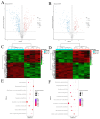Comparative Physiological, Proteomic, and Metabolomic Insights into a Promising Low-Pruning Mulberry Cultivar for Silkworm Rearing
- PMID: 39769246
- PMCID: PMC11678587
- DOI: 10.3390/ijms252413483
Comparative Physiological, Proteomic, and Metabolomic Insights into a Promising Low-Pruning Mulberry Cultivar for Silkworm Rearing
Abstract
Mulberry (Morus spp.) is an economically significant plant in the production of silk through feeding leaves to silkworm larvae. Traditional silkworm rearing is heavily labor-intensive, particularly in leaf collection, which leads to low efficiency and impedes the development of sericulture. Here, to assess the feasibility and effectiveness of a novel low-pruning mulberry cultivar, ZJ1, in the silkworm rearing industry, a comprehensive investigation integrating physiological, proteomic, and metabolomic analyses was conducted in comparison with the traditionally high-pruning cultivar, N14. The low-pruning mulberry variety ZJ1 exhibited a notable increase in annual leaf yield of 43.94%, along with a significant enrichment of serine and isoleucine contents, in contrast to those of the high-pruning variety N14. Through iTRAQ proteomics and LC-MS/MS metabolomics analyses, a total of 561 reduced and 803 increased differentially expressed proteins (DEPs), as well as 332 differential expressed metabolites (DEMs) in positive ions and 192 DEMs in negative ions, were identified in the ZJ1 group relative to the N14 group, respectively. The observed features in amino acid profiles and the enrichment of the sucrose-related metabolic pathway provided interesting insights for future endeavors in mulberry variety improvement and the optimization of silkworm diet formulations. Collectively, the low-pruning cultivar ZJ1, characterized by its rapid growth, high leaf productivity, and suitability for mechanized operations, is expected to be an efficient substitute in improving the future sericultural industry, especially in urbanized and industrialized regions.
Keywords: low-pruning cultivation; metabolomics; mulberry; proteomics; sericulture.
Conflict of interest statement
The authors declare that the research was conducted in the absence of any commercial or financial relationships that could be construed as a potential conflict of interest.
Figures






Similar articles
-
Proteomics Provides Insight into the Interaction between Mulberry and Silkworm.J Proteome Res. 2017 Jul 7;16(7):2472-2480. doi: 10.1021/acs.jproteome.7b00071. Epub 2017 Jun 12. J Proteome Res. 2017. PMID: 28503925
-
iTRAQ-Based Quantitative Proteomic Analysis of Digestive Juice across the First 48 Hours of the Fifth Instar in Silkworm Larvae.Int J Mol Sci. 2019 Dec 4;20(24):6113. doi: 10.3390/ijms20246113. Int J Mol Sci. 2019. PMID: 31817210 Free PMC article.
-
SWATH-based quantitative proteomics reveals the mechanism of enhanced Bombyx mori nucleopolyhedrovirus-resistance in silkworm reared on UV-B treated mulberry leaves.Proteomics. 2017 Jul;17(13-14). doi: 10.1002/pmic.201600383. Epub 2017 Jun 29. Proteomics. 2017. PMID: 28556443
-
Bibliometric Analysis of Trends in Mulberry and Silkworm Research on the Production of Silk and Its By-Products.Insects. 2022 Jun 23;13(7):568. doi: 10.3390/insects13070568. Insects. 2022. PMID: 35886744 Free PMC article. Review.
-
The advent of genomics in mulberry and perspectives for productivity enhancement.Plant Cell Rep. 2011 May;30(5):825-38. doi: 10.1007/s00299-011-1059-1. Epub 2011 Mar 23. Plant Cell Rep. 2011. PMID: 21431349 Review.
References
-
- Rohela G.K., Shukla P., Muttanna R., Kumar S.R. Chowdhury, Mulberry (Morus spp.): An ideal plant for sustainable development. Trees For. People. 2020;2:100011. doi: 10.1016/j.tfp.2020.100011. - DOI
-
- Savithri G., Sujathamma P., Asha K.V. Silkworm Bombyx mori an economic insect. Int. J. Sci. Res. 2013;2:2535–2537. doi: 10.15373/22778179/JULY2013/187. - DOI
-
- Krishna K.J., Ishita B., Mayookha V.P. Recent trends in the development and diversification of sericulture natural products for innovative and sustainable applications. Bioresour. Technol. Rep. 2021;13:100614. doi: 10.1016/j.biteb.2020.100614. - DOI
-
- Murthy D.V.N.Y., Ramesh H.L., Munirajappa D., Yadav D.B.R.D. Nutritional quality assessment of ten mulberry (Morus) germplasm varieties through moulting test, silkworm rearing technique and economical characters of bivoltine silkworms (Bombyx mori L.) for commercial exploitation. Int. Res. J. Natural Sci. 2013;1:11–22. doi: 10.37745/irjns.13. - DOI
Publication types
MeSH terms
Substances
Grants and funding
LinkOut - more resources
Full Text Sources
Miscellaneous

